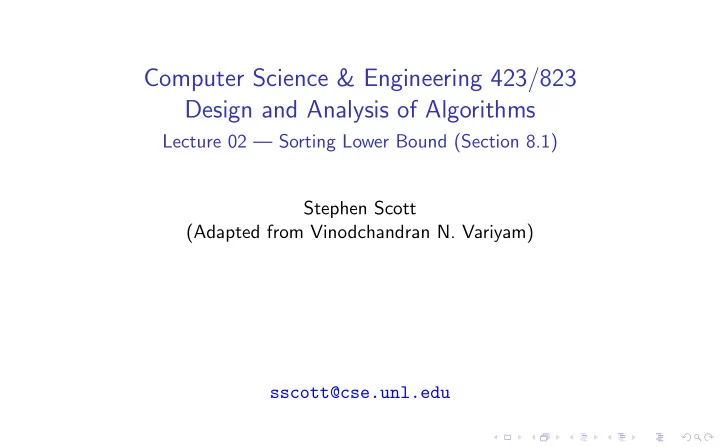

Computer Science & Engineering 423/823 Design and Analysis of Algorithms Lecture 02 — Sorting Lower Bound (Section 8.1) Stephen Scott (Adapted from Vinodchandran N. Variyam) sscott@cse.unl.edu
Introduction ◮ Impossibility of algorithms: There are some problems that cannot be solved ◮ We’ll visit this throughout the semester, especially with NP-completeness ◮ Today’s example: there does not exist a general-purpose ( comparison-based ) algorithm to sort n elements in time o ( n log n ) ◮ Will show this by proving an Ω( n log n ) lower bound on comparison-based sorting
Comparison-Based Sorting Algorithms ◮ What is a comparison-based sorting algorithm? ◮ The sorted order it determines is based only on comparisons between the input elements ◮ E.g., Insertion Sort, Selection Sort, Mergesort, Quicksort, Heapsort ◮ What is not a comparison-based sorting algorithm? ◮ The sorted order it determines is based on additional information, e.g., bounds on the range of input values ◮ E.g., Counting Sort, Radix Sort
Decision Trees ◮ A decision tree is a full binary tree that represents comparisions between elements performed by a particular sorting algorithm operating on a certain-sized input ( n elements) ◮ Key point: a tree represents algorithm’s behavior on all possible inputs of size n ◮ Each internal node represents one comparison made by algorithm ◮ Each node labeled as i : j , which represents comparison A [ i ] ≤ A [ j ] ◮ If, in the particular input, it is the case that A [ i ] ≤ A [ j ], then control flow moves to left child, otherwise to the right child ◮ Each leaf represents a possible output of the algorithm, which is a permutation of the input ◮ All permutations must be in the tree in order for algorithm to work properly
Example for Insertion Sort ◮ If n = 3, Insertion Sort first compares A [1] to A [2] ◮ If A [1] ≤ A [2], then compare A [2] to A [3] ◮ If A [2] > A [3], then compare A [1] to A [3] ◮ If A [1] ≤ A [3], then sorted order is A [1], A [3], A [2]
Example for Insertion Sort (2) ◮ Example: A = [7 , 8 , 4] ◮ First compare 7 to 8, then 8 to 4, then 7 to 4 ◮ Output permutation is � 3 , 1 , 2 � , which implies sorted order is 4, 7, 8
Proof of Lower Bound ◮ Length of path from root to output leaf is number of comparisons made by algorithm on that input ◮ Worst-case number of comparisons is length of longest path (= height h ) ◮ Number of leaves in tree is n ! ◮ A binary tree of height h has at most 2 h leaves √ � n ◮ Thus we have 2 h ≥ n ! ≥ � n 2 π n e ◮ Take base-2 logs of both sides to get √ h ≥ lg 2 π + (1 / 2) lg n + n lg n − n lg e = Ω( n log n ) ⇒ Every comparison-based sorting algorithm has an input that forces it to make Ω( n log n ) comparisons ⇒ Mergesort and Heapsort are asymptotically optimal
Another Lower Bound: Convex Hull ◮ Can use the lower bound on sorting to get a lower bound on the convex hull problem: ◮ Given a set Q ∈ { p 1 , p 2 , . . . , p n } of n points, each from R 2 , output CH( Q ), which is the smallest convex polygon P such that each point from Q is on P ’s boundary or in its interior
Another Lower Bound: Convex Hull (cont’d) ◮ We will reduce the problem of sorting to that of finding a convex hull ◮ I.e., given any instance of the sorting problem A = { x 1 , . . . , x n } , we will transform it to an instance of convex hull such that the time complexity of the new algorithm sorting will be no more than that of convex hull ⇒ If convex hull could be solved in time o ( n log n ) then so can sorting ⇒ Since that cannot happen, we know that convex hull is Ω( n log n ) ◮ The reduction: transform A to Q = { ( x 1 , x 2 1 ) , ( x 2 , x 2 2 ) , . . . , ( x n , x 2 n ) } ⇒ Takes O ( n ) time ◮ Since the points on Q are on a parabola, all points of Q are on CH( Q ) ⇒ Can read off the points of CH( Q ) in O ( n ) time ⇒ Yields a sorted list of points from ( any ) A ◮ Time to sort A is O ( n )+ convex hull + O ( n ) ◮ If time for convex hull is o ( n log n ), then sorting is o ( n log n ) ⇒ Convex hull time complexity is Ω( n log n )
Recommend
More recommend